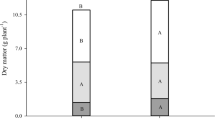Summary
The influence of magnesium nutrition on fruit quality of sweet orange was investigated in sand culture, and the relationships between Mg and fruit quality were explored in the field.
In the glasshouse, fruit produced over 3 seasons by cuttings, cv. ‘Washington Navel’ grown with high and low Mg nutrient solutions were compared with controls (5.29, 0.37, and 1.62 milliequivalents Mg++/L). High Mg resulted in fruit with a much greater juice acid content than the control, other effects on fruit quality attributes were small and mostly non-significant. High Mg depressed uptake of Ca, but not K indicating a Ca-Mg antagonism. Phosphorus uptake was depressed by both high and low Mg compared to the controls. Leaf concentrations of Mg were: 0.595, 0.178, and 0.392 per cent (means over 3 seasons) in the high, low Mg and controls.
In the field, fruit from ‘Washington Navel’ trees on Rough Lemon rootstock had acid levels that correlated well with leaf K, also with (K+Mg): Ca ratio. Leaf levels of Mg were below 0.4 per cent. ‘Late Valencia’ on Poncirus trifoliata rootstock produced fruit with higher acid levels which correlated with leaf Mg (mostly > 0.4 per cent), also with K+Mg: Ca ratio. Therefore, Mg was a significant predictor of juice acidity when Mg levels were high.
Similar content being viewed by others
References
Anon. Citrus rootstock influences magnesium deficiency. Agric. Gaz. N.S.W. 78, 484 (1967).
Bingham F. T., McColloch R. C. and Aldrich D. G., Interrelation of soil potassium and magnesium. California Citrogr. 46, 122, 132–134 (1956).
Bouma D., Studies in citrus nutrition. 2. Phosphorus deficiency and fruit quality. Australian J. Agr. Research 7, 261–271 (1956).
Cary P. R., The residual effects of nitrogen, calcium and soil management treatment on yield, fruit size and composition of citrus. J. Hort. Sci. 47, 479–491 (1972).
Domnicz A., (Influence of magnesium on the phosphorus economy of plants. Part V Influence of magnesium on the uptake and metabolism of phosphorus in maize and ryegrass). In Polish with English summary. Acta Agr. Silvestr. 1, 47–84 (1961).
Domnicz A., (Influence of magnesium on the phosphorus economy of plants. Part VI The metabolism of phosphorus and the content of nitrogen, phosphorus, potassium, calcium and magnesium in plants of maize and oats as related to increasing concentrations of magnesium acetate in the nutrient medium). In Polish with English summary. Acta Agr. Silvestr. 10, 107–120. (1970).
Duncan, J., Citrus nutrition survey — M.I.A. I.R.E.C. Farmers Newsl. Griffith No. 105, 17–19. (1969).
Embleton T. W., Magnesium. In Diagnostic Criteria for Plants and Soils (Edit. H. D.Chapman) Univ. California Berkeley pp. 225–263 (1966).
Embleton T. W., Jones W. W., Page A. L. and Platt R. G., Potassium and California citrus. Proc. 1st Intenl. Citrus Symp., Riverside Calif. 3, 1599–1603 (1969).
Fudge B. R., The effect of applications of calcium and magnesium upon absorption of potassium by citrus. Proc. Florida Sta. Hort. Soc. 59, 46–51 (1946).
Haas A. R. C., and Brusca J. N., Valencia orange fruit size. California Agric. 8(7), 13–14 (1954).
Jacoby B., Calcium-magnesium ratios in the root medium as related to magnesium uptake by citrus seedlings. Plant and Soil 15, 74–80 (1961).
M.I.A. Citrus Marketing Association, M.I.A. citrus quality. I.R.E.C. Farmers Newsl. Griffith, No. 100, 20–21 (1970).
Moss G. I., The role of potassium in determining fruit quality of sweet orange. Australian J. Exp. Agr. Animal Husb. 12, 195–202 (1972a).
Moss, G. I., Citrus fruit quality in the M.I.A. Part I Preliminary investigations. I.R.E.C. Farmers Newsl. Griffith, No. 114, 20–23 (1972b).
Pratt P. F. and Harding R. B., Loss of magnesium from soil. California Agric. 11, 11 (1957).
Proctor J., Magnesium as a toxic element. Nature 227, 742–743 (1970).
Smith P. F., Scudder G. K. and Hrnciar G., Comparison of four varieties of young and old budline oranges grown in sand cultures with three potassium levels. Proc. Florida Sta. Hort. Soc. 83, 6–11 (1970).
Taylor, J. K. and Hooper, P. D., A soil survey of the horticultural soils in the Murrumbidgee Irrigation Areas, New South Wales. Bull. C.S.I.R. Melbourne No. 118, (pp. 78–80 quoted). (1938).
Tucker, B. M., Basic exchangeable cations in soils. Div. Soils Tech. Paper No. 8, C.S.I.R.O. (1971).
Wallace A. and Ashcroft R. T., Correlations of phosphorus and magnesium contents of plants grown in synthetic ion-exchange resins. Agron. J. 48, 219–222 (1956).
Weir C. C., Potassium and magnesium nutrition of citrus trees. Trop. Agr. 46, 131–136 (1969).
Author information
Authors and Affiliations
Rights and permissions
About this article
Cite this article
Moss, G.I., Higgins, M.L. Magnesium influences on the fruit quality of sweet orange (Citrus sinensis L. osbeck). Plant Soil 41, 103–112 (1974). https://doi.org/10.1007/BF00017948
Received:
Issue Date:
DOI: https://doi.org/10.1007/BF00017948




